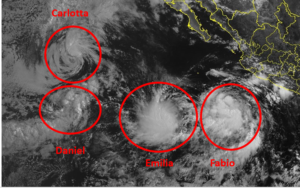Tropical Storms Barbara and Cosme were spinning over the Eastern North Pacific Ocean west of Mexico on Tuesday morning. At 5:00 a.m. EDT on Tuesday the center of Tropical Storm Barbara was located at latitude 19.1°N and longitude 108.1°W which put the center about 180 miles (290 km) west-southwest of Cabo Corrientes, Mexico. Barbara was moving toward the northwest at 8 m.p.h. (13 km/h). The maximum sustained wind speed was 60 m.p.h. (95 km/h) and there were wind gusts to 75 m.p.h. (120 km/h). The minimum surface pressure was 999 mb.
Former Hurricane Barbara weakened back to a tropical storm as it moved over cooler water south of Baja California during Monday night. Thunderstorms were still occurring near the center of Barbara’s circulation. Those thunderstorms generated upper level divergence that pumped mass away from the tropical storm. However, the upper level divergence pumped away less mass than was converging in the lower level’s of Barbara’s circulation. The accumulation of mass in the lower levels caused the surface pressure to increase.
The circulation around Tropical Storm Barbara was small. Winds to tropical storm force extended out 70 miles (110 km) from the center of Barbara’s circulation.
Tropical Storm Barbara will move through an environment unfavorable for intensification during the next 24 hours. Barbara will move over water where where the Sea Surface Temperatures are near 24°C. It will move under the middle part of an upper level ridge over Mexico and the Eastern North Pacific Ocean. The upper level winds are weak near the middle of the ridge and there will be little vertical wind shear. Tropical Storm Barbara will continue to weaken during the next 24 hours as it moves over colder water.
Tropical Storm Barbara will move around the southwestern part of a high pressure system over Mexico. The high pressure system will steer Barbara toward the northwest during the next 24 hours. On its anticipated track, Tropical Storm Barbara will move slowly toward the southern end of Baja California.
Elsewhere over the Eastern North Pacific Ocean, Tropical Storm Cosme was spinning south of Baja California. At 5:00 a.m. EDT on Tuesday the center of Tropical Storm Cosme was located at latitude 15.3°N and longitude 114.5°W which put the center about 605 miles (975 km) south-southwest of the southern tip of Baja California. Cosme was moving toward the west-northwest at 5 m.p.h. (8 km/h). The maximum sustained wind speed was 70 m.p.h. (110 km/h) and there were wind gusts to 85 m.p.h. (135 km/h). The minimum surface pressure was 993 mb.
Tropical Storm Cosme maintained its intensity during Monday night. Thunderstorms were occurring near the center of Cosme’s circulation. Thunderstorms were also occurring in bands in the western side of Tropical Storm Cosme. Bands in the eastern side of Cosme’s circulation consisted primarily of showers and lower clouds. Storms near the center of Cosme generated upper level divergence that pumped mass away from the tropical storm. The removal of mass in the upper levels was almost the same as the inflow of mass in the lower level of Tropical Storm Cosme. As a result of the balance of inflow and outflow, the surface pressure remained nearly constant.
The circulation around Tropical Storm Cosme was small. Winds to tropical storm force extended out 85 miles (135 km) from the center of Cosme’s circulation.
Tropical Storm Cosme will move through an environment slightly unfavorable for intensification during the next 24 hours. Cosme will move over water where where the Sea Surface Temperatures are near 25°C. It will move under the southern side of an upper level ridge over Mexico and the Eastern North Pacific Ocean. The upper level ridge will produce easterly winds that will blow toward the top of Cosme’s circulation. Those winds will cause some vertical wind shear. The combination of cooler Sea Surface Temperatures and some vertical wind shear will likely cause Tropical Storm Cosme to start to weaken during the next 24 hours.
Tropical Storm Cosme will move around the western part of a high pressure system over Mexico. The high pressure system will steer Cosme toward the north during the next 24 hours. On its anticipated track, Tropical Storm Cosme will remain far to the south of Baja California.

